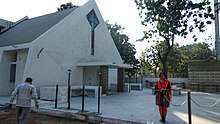Methodist Church in India
Methodist Church in India is a Protestant Christian denomination of India. Its seat is in Mumbai.[1] The Church shares it roots with American Methodism brought by American missionaries distinguished from traditional British Methodism. The Methodist Churches (of British and Australian conferences) joined Church of South India and the Church of North India are the results of mergers involving Church of England, British Methodist Churches and other Protestant denominations under episcopal Anglican orientation. Methodism came to India in 1856.[2] The Methodist Church of India remained affiliated with United Methodist Church in USA. It has hundreds of thousands of members.[3] It is a member of the World Council of Churches, Christian Conference of Asia, the National Council of Churches in India and World Methodist Council.[3] It runs schools.[3]
| Methodist Church in India | |
|---|---|
 | |
| Classification | Protestant (Methodist) |
| Associations | World Council of Churches, Christian Conference of Asia, the National Council of Churches in India and World Methodist Council |
| Congregations | 2,460 |
| Members | 648,000 |
| Official website | https://worldmethodistcouncil.org |
| Part of a series on |
| Methodism |
|---|
 |
|
Theology |
|
Organization
|
|
Other topics
|
|
|

The Methodist Church in India (MCI), is an "autonomous affiliated" Church in relation to the United Methodist Church.[4][5]
History
In 1856 the Methodist Episcopal Church From America started the mission in India. The Methodist Episcopal Church began its work in India in 1856, when William Butler came from America. He selected Oudh and Rohilkhand to work in and, being unable to secure a residence at Lucknow, began work at Bareilly. The first War of Independence broke up the work at Bareilly, but in 1858 Lucknow was occupied and Bareilly re-occupied and the work of the Mission started anew.
By 1864 the work had grown to such an extent that it was organized under the name of the India Mission Conference. Additional stations were occupied in Oudh, Rohilkhand, Garhwal, and Kumaon, and by 1876 The Methodist Episcopal Church had established work both along evangelistic and educational lines.
Methodist Churches were established in cities including Mumbai, Kolkata, Chennai, Kanpur and Bangalore. Special revival meetings were held which led the church out of its boundaries and gave it a national status.
In 1870 marked, on the invitation of James M. Thoburn, an acknowledged leader in the Mission, evangelist William Taylor was invited to India to hold special revival meetings. On his arrival, he started his work at Lucknow and subsequently went to Kanpur. The work had thus far been confined to the territory East and North of the Ganges, but by that river; this move was the first step of expansion into all Southern Asia. There came into existence Methodist congregations in Kanpur, Bombay, Poona, Calcutta, Secunderabad, Madras, Bangalore, Nagpur and other cities.[6]
In 1873 the churches established by William Taylor were organized into the "Bombay-Bengal Mission." In 1876 the South India Annual Conference was organized, taking in all the territory outside the bounds of the original Upper India field. This was followed in 1888 by the organization of the Bengal Annual Conference, and in 1893 the Bombay and North-West India Annual Conferences were separated. Between 1871 and 1900 the Methodist Episcopal Church expanded to become a national Church throughout Southern and South-Eastern Asia, with work carried on in twelve languages, extending from Manila to Quetta and from Lahore to Madras; and the Christian community increased from 1,835 to 111,654.
In 1904 the field was again sub-divided by the organization of the Central Provinces Mission Conference, which was followed by setting the work of Burma apart and organizing it as a Mission Conference. In 1921 two Annual Conferences, Lucknow and Gujarat were brought into existence and another division of the field was made in 1922 when the Indus River Annual Conference was organized. In 1925 the Hyderabad Annual Conference was separated from the South India Annual Conference. In 1956 Agra Annual Conference was separated from Delhi Annual Conference and Moradabad Annual Conference from the North India Annual Conference. In 1960 the Karachi Provisional Annual Conference was organized. Thus in 95 years from 1865 to 1960, the one Conference in India had grown into 13, covering the whole of Southern Asia.
In this period the work of the Methodist Episcopal Church spread beyond India. Under the leadership of James M. Thoburn, Burma was entered in 1879, where John E. Robinson became the pioneer missionary, and in 1885 the work in Malaysia was begun by the establishment of a mission at Singapore, the pioneer here being William F. Oldham. In 1899, when the Philippines came into the possession of the United States of America, James M. Thoburn entered Manila and established the Church; Homer C. Stuntz was one of the pioneer workers. All these missionary leaders later became Bishops of the Church.
In 1870 the first missionaries of the Woman's Foreign Missionary Society of the Methodist Episcopal Church came. Two young ladies arrived that year: Isabella Thoburn, to work in the education of India's girls and women, and physician Clara Swain, to work in medicine, the first female doctor to undertake such work in Asia.
Evangelistic work in the villages of northern India resulted in the baptism of large numbers of people from the deprived classes.
In 1920 the Methodist Missionary Society was organized to supervise missionary work in India. In 1930 the Central Conference of southern Asia elected the first national bishop. Since the Independence of India in 1947 all bishops have been Indian nationals. Missionaries were sent to Borneo in 1956 and to the Fiji islands in 1963.
Since 1928 the MCI was engaged in union negotiations in North India. In 1970 the Central Conference voted against the plan of union, but dialogue with the Church of North India continued.
In 1981 the Methodist Church in India was established as an "autonomous affiliated" church in relation with the United Methodist church. The church is now independent in organization and has adopted its own constitution and book of discipline and articles of faith.
Beliefs
The Methodist Church in India says that it understands itself as the body of Christ in and for the world as part of the Church universal. Its stated purpose is to understand the love of God as revealed in Jesus Christ, to bear witness of this love to all people and to make them his disciples.
Social work
The MCI runs 102 boarding schools and 155 village schools in which over 60,000 children are enrolled. 89 residential hostels cater for 6,540 boys and girls. The Church also operates 19 College and vocational training institutions, 25 hospitals and health care centres, and many community welfare and development programmes in the country
Parish
Chandigarh
| S. No. | Parish | Address |
|---|---|---|
| St. Paul's Methodist Church | Roorkee Road, Meerut Cantt. | |
| St. John's Church | Meerut. | |
| St. Thomas Church | Baccha Park (Children's Park) Meerut | |
| St. Methodist Church | G T Road, Ghaziabad. | |
Lucknow
| S. No. | Name | Address |
|---|---|---|
| 1 | Central Methodist Church | 37 Cantonment road, Lucknow. |
| 2 | Lal Bagh Methodist Church | Foresyth Road, Near Dhayanidhan park, Lal Bagh, Lucknow. |
| 3 | Ganeshganj Methodist Church | Aminabad road, Lucknow. |
| 4 | Daliganj Methodist Church | Acharya narendradev Marg, Daliganj, Lucknow. |
| 5 | Shalom Methodist Church | Sector 4, Vrindavan colony, Lucknow. |
| 6 | Christ Methodist Church | Ram puram, Behind Gayatri Mandir, Kursi Road,Lucknow. |
Mumbai
| S. No. | Name | Address |
|---|---|---|
| 1 | Centenary Methodist Gujarati Church | M.S Ali road, Grant Road east, Mumbai. |
| 2 | Bowen Memorial Methodist Church | Tullock Road, Apollo Bandar, Colaba, Mumbai. |
| 3 | Robinson Memorial Methodist Central Church | Shaikh Hafizuddin Marg, Ashadham Colony, Madanpura, Mumbai. |
| 4 | Rahator Memorial Methodist Church | Parel, Mumbai. |
| 5 | Warner Memorial Methodist Church | Ambedkar Nagar, Kurla, Mumbai. |
| 6 | Vernon Memorial Methodist Church | Syndicate, Kalyan, Mumbai. |
| 7 | Sumang Methodist Kannada Church | Vithalwadi, Kalyan East, Mumbai. |
| 8 | Methodist Marathi Church Thane | Gokuldham Society, Thane East |
| 9 | Bethel Kannada Methodist Church Matunga | Matunga M.L Camp, Matunga |
| 10 | Methodist Church Ambernath | kalyan-badlapur road, Ambernath |
Kanpur
| S. No. | Name | Address |
|---|---|---|
| 1 | Methodist Church Chakeri | Harjinder Nagar, Chakeri, Kanpur. |
| 2 | LLJM Methodist Church | Post Office Lane, Civil Lines, Kanpur. |
| 3 | Methodist Church | Noronha Road, Cantonment, Kanpur. |
| 4 | Methodist High School Church | P Road, Gumti, Kanpur. |
| 5 | Sofi Shukla Memorial Methodist Church | Hamirpur Road, Baradevi, Kidwai Nagar, Kanpur. |
| 6 | Methodist Church | Varkitola, Phaphund. |
Gandhinagar (Gujarat)
| S. No. | Name | Address |
|---|---|---|
| 1 | Methodist Church | Plot # 46, Sector 23, Gandhinagar - 382024. |
Ahmedabad (Gujarat)
| S. No. | Name | Address |
|---|---|---|
| 1 | Methodist Tamil Church | No.3 & 4 Anupam Nagar Society, Near Carmel Methodist Church, Near CTM, Ahmedabad. |
Nagpur (Maharashtra)
| S. No. | Name | Address |
|---|---|---|
| 1 | Methodist Hindi Church | Mecosabagh Methodist High School, Mecosabagh Christian Colony, Kadbi Chowk - 440014 |
Nanded District (Maharashtra)
| S. No. | Name | Address |
|---|---|---|
| 1 | Nanded Methodist Church | Methodist Church Near SP office Nanded police headquarter road,vazirabad,Nanded-431601 |
See also
References
- "Archived copy". Archived from the original on 2009-01-25. Retrieved 2010-03-27.CS1 maint: archived copy as title (link)
- https://www.umnews.org/en/news/building-bridges-with-methodist-church-in-india
- "Archived copy". Archived from the original on 2012-03-08. Retrieved 2010-03-29.CS1 maint: archived copy as title (link)[sub]=1
- "The Methodist Church in India: Bangalore Episcopal Area". The United Methodist Church GBGM. Archived from the original on 2012-05-24. Retrieved 2007-10-18.
- "India Methodists celebrate 150 years of ministry". The United Methodist Church. Archived from the original on 2006-12-06. Retrieved 2007-10-18.
- The Book of Discipline of The United Methodist Church, 1976 Historical Statement, pp 7-11.